George Frampton
Sir George James Frampton, RA (18 June 1860 – 21 May 1928) was a notable British sculptor. He was a leading member of the New Sculpture movement in his early career when he created sculptures with elements of Art Nouveau and Symbolism, often combining different materials such as marble and bronze in a single piece.[1] While his later works were more traditional in style, Frampton had a prolific career in which he created many notable public monuments, including several statues of Queen Victoria and later, after World War I, a number of war memorials.[1] These included the Edith Cavell Memorial in London, which, along with the Peter Pan statue in Kensington Gardens are possibly Frampton's best known works.[1]
Sir George James Frampton | |
|---|---|
_by_WH_Latham.jpg.webp) Portrait of Frampton by W. H. Latham | |
| Born | 18 June 1860 London, England |
| Died | 21 May 1928 (aged 67) |
| Nationality | British |
| Alma mater |
|
| Known for | Sculpture |
| Movement | New Sculpture |
| Spouse(s) | Christabel Cockerell (m.1893) |
Biography
Early life
Frampton was born on 18 June 1860 in London, where his father was a woodcarver and stonemason.[2] George Frampton began his own working life as a stone carver in 1878, working on the Hôtel de Ville in Paris.[2] Frampton returned to London to study under William Silver Frith at the South London Technical School of Art during 1880 and 1881.[3] He went on to the Royal Academy Schools where, between 1881 and 1887 he won a gold medal and travelling scholarship.[3] While still studying at the Royal Academy, Frampton undertook a number of sculpture commissions including, in 1885, pieces for the facade of both the Constitutional Club in Northumberland Avenue and for the Chelsea Conservative Club.[2] He also created an altarpiece for Manchester Cathedral, some decorative pieces for the Henry Fawcett Memorial in London and a pair of terracotta figures representing Concord and Industry which were exhibited in Paris and purchased for the Municipal Building in Christchurch, New Zealand.[4] From 1887 to 1890 Frampton studied and worked at the studio of Antonin Mercie in Paris, where he also studied painting under Pascal Dagnan-Bouveret and Gustave Courtois.[2][5]
Early works

Frampton returned to England and, briefly, worked in the studio of Sir Joseph Edgar Boehm.[2] He then took up a teaching post at the Slade School of Art in 1893 and was also, for a year, the joint head of the Central School of Arts and Crafts.[4][6]
In 1893 Frampton married the artist Christabel Cockerell and the couple set up home together at St John's Wood in London. Together they designed a decorative frieze for the interior of the house and Frampton began to design household fittings, jewellery in enamel and precious metals and also medals, most notably for Glasgow University and Winchester College.[4] By this time, Frampton was, according to the critic M.H. Spielmann "in open rebellion against white sculpture". In 1893 he showed Mysteriarch, a polychromatic plaster bust with Symbolism motifs at the Royal Academy and, two years later he showed another polychromatic work, Mother and Child at the same venue.[4] Mother and Child has bronze figures, of Frampton's wife and son, set against a copper plaque, and a white enamel disc behind the mother's head.[4][7] In his statue of Dame Alice Owen (1895) Frampton combined bronze and marble, and, later, with the bust Lamia (1899-1900) he contrasted an ivory head and neck with bronze clothing inlaid with opels.[2][8][9]
In 1896 Frampton exhibited, with the architect Charles Harrison Townsend, a large fireplace in American walnut at the Arts and Crafts Exhibition Society.[4] The fireplace was decorated with an innovative tree and foliage design by Frampton that was subsequently much imitated by Art Nouveau and Arts and Crafts designers and became known as the 'Frampton tree'.[4] Frampton used a similar design in his 1897 memorial to Charles Mitchell for St George's Church in Jesmond in Newcastle upon Tyne.[4]
Recognition
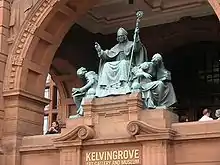
Frampton's body of work in the 1880s brought him considerable recognition. The University of St Andrews awarded him an honorary doctorate in 1894.[2] In 1897 examples of Frampton's work featured at the Venice Biennale and at the Vienna Secession the following year.[2] He exhibited at the La Libre Esthétique in Brussels and showed four pieces at the Paris International Exhibition in 1900 for which he was awarded the Grand Prix.[4]
Recognition also brought Frampton two significant public commissions at this time. The architect John William Simpson appointed Frampton as master sculptor for the decoration of the facade of the Kelvingrove Art Gallery and Museum in Glasgow.[4] As well as overseeing the work of several other sculptors, Frampton created a bronze sculpture group and three sets of stone spandrels for the north porch of the new building.[10] The sculpture group, of St Mungo attended by the muses of Art and Music, in the central arch of the porch contains Symbolism style motiffs featuring trees, bells and fishes similar to those Frampron had used in some of his earlier smaller pieces.[4] Frampton's other commission was for a frieze on the facade of the Lloyd's Register building in Fenchurch Street in London. There, Frampton created, at first floor level, a frieze in Portland stone of female figures representing Trade, Commerce and Shipping with four bronze statuettes at key points.[4][11] Both commissions, but especially the Fenchurch Street frieze, were widely praised at the time.[4]
Later career
In April 1897 a public meeting in Kolkata agreed to raise funds to mark the Diamond Jubilee of Queen Victoria and, eventually, commissioned Frampton to create a statue of the monarch.[12] Photographs of Frampton's model for the statue were published in the July 1898 edition of The Studio. The accompanying text described a figure over twice life-size, seated under a canopy, wearing the robe of the Order of the Star of India, decorated in gold, ivory and lapis lazuli. The completed statue, which was considerably less ornate and without a canopy, was shipped to India early in 1901 and erected on a temporary site in March 1902.[4] The statue was subsequently moved to a location in front of the Victoria Memorial, where it was sited on a large architectural podium.[4] The death of Queen Victoria in January 1901 led to Frampton receiving several commissions for memorials to the Queen. Frampton based several of these on his design of a seated figure he used for the Kolkata statue but with some variations. He used the same cast for the Leeds and St Helens's statues but changed the style of the decorative details and pedestals between them.[13][14] A further version was created for the grounds of the Manitoba Legislative Building in Winnipeg in 1904.[15] A different design of a much younger, standing Victoria was created for the Royal Victoria Infirmary in Newcastle upon Tyne in 1906 and was unveiled by her son King Edward VII in the same year.[16]
_in_1915_(cropped).jpg.webp)
Among Frampton's other notable public sculptures are the figures of Peter Pan playing a set of pipes, the lions at the British Museum and the Edith Cavell Memorial that stands outside the National Portrait Gallery, London.[5] The original Peter Pan statue in Kensington Gardens, London, was commissioned by J.M. Barrie in 1912. Barrie was said to be disappointed at Frampton's depiction of Peter Pan, in particular at his choice of model for the figure of the boy.[17] However such was the popularity of the statue, six more casts were made which are now situated in:
- Perth, Western Australia, Australia
- Parc d'Egmont, Brussels, Belgium
- Bowring Park, St. John's, Newfoundland, Canada
- Toronto, Canada
- Sefton Park, Liverpool, England
- Camden, New Jersey, United States.
By March 1905 Aston Webb, the architect of the Cromwell Road extension to the Victoria and Albert Museum had commissioned over twenty sculptors to provide statues, carvings and decorations for the facade of the building.[4] Webb allocated what he considered the two most important areas to Frampton and Alfred Drury.[4] The area over the main entrance arch was allocated to Frampton who created spandrel figures of Truth and Beauty for the space while the remainder of the main entrance was assigned to Drury.[18]
A number of Frampton's works can be seen at the restored St James' Church, Warter in East Yorkshire. Frampton created Dr Barnardo's Memorial, in Barkingside, London, in 1908, a work he undertook without claiming a fee.[19]
During World War I Frampton used his position in various art socities and institutions to expel any German members he considered potential "enemy aliens". When the Art Workers Guild refused to expel Karl Krall, a British citizen born in Germany, Frampton resigned from the Guild.[17] In 1915 Frampton was commissioned to create a public memorial to Edith Cavell. Having waived his fee for the work, Frampton's modernist style monument in marble and granite was unveiled to huge crowds near Trafalgar Square in central London during 1920.[20] Several contemporary sculptors criticised the design and the engineering of the monument.[20]
Frampton subsequently worked with Sir Edwin Lutyens on two of the architect's war memorials in the aftermath of the First World War, the Hove War Memorial in East Sussex and the Fordham War Memorial in Cambridgeshire, unveiled in February and August 1921 respectively. Both feature a bronze statue of Saint George, sculpted by Frampton atop a column designed by Lutyens.[21]
Personal life
Frampton's first house and studio was at 32 Queen's Grove (where a blue plaque to his name has been erected), but he later built a larger house nearby in Carlton Hill,[22] both in St John's Wood, London. He was married to the artist Christabel Cockerell and had one son, the painter and etcher Meredith Frampton.[5] He was an active member of The Art Workers' Guild and became Master in 1902. He sculpted the Art Workers' Guild's Master's Jewel in silver representing 'Art is Unity'
He died on 21 May 1928 aged 67 and was cremated at Golders Green Crematorium on 25 May. His ashes lie in a niche on the ground floor of the east wing of the Ernest George Columbarium. A memorial sculpted by Ernest Gillick in 1930 depicting a bronze child holding a miniature copy of Frampton's statue of Peter Pan is located in the Crypt of St. Paul's Cathedral.[17]
Public monuments
1896–1904
| Image | Title / subject | Location and coordinates |
Date | Type | Material | Dimensions | Designation | Wikidata | Notes |
|---|---|---|---|---|---|---|---|---|---|
 More images |
Arthurian door | Two Temple Place, London | 1896 | 9 low-relief door panels | Silver-gilt | [4] | |||
 More images |
William Rathbone VI | St John's Gardens, Liverpool | 1899 | Statue on pedestal | Bronze and stone | Grade II | Q26333151 | [23] | |
 More images |
Queen Victoria | Grounds of the Victoria Memorial, Kolkata | 1901 | Statue on pedestal and steps | Bronze and stone | Q92360272 | [4] | ||
.jpg.webp) More images |
St. Mungo as the Patron of Art and Music | Kelvingrove Art Gallery and Museum, Glasgow | 1901 | Sculpture group | Bronze | [4] | |||
 |
William Howitt & Mary Howitt | Nottingham Castle | 1901 | Bas relief on plinth | Bronze and granite | [24] | |||
.JPG.webp) More images |
Statue of Queen Victoria | Victoria Square, St Helens, Merseyside | 1902 | Seated statue on pedestal | Bronze on sandstone and granite | 6.4m | Grade II* | Q15979535 | [25] |
.jpg.webp) More images |
Walter Besant | Savoy Place, Victoria Embankment, London | 1902, erected 1904 | Plaque | Bronze | Q27096149 | A cast of an identical monument in the crypt of St Paul's Cathedral, unveiled in 1903. | ||
 More images |
Memorial to Queen Victoria | Woodhouse Moor, Leeds | 1903, unveiled 1905 | Seated statue, frieze and figures on column | Bronze and Portland stone | Grade II* | Q15979175 | [26][27] | |
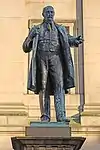 More images |
Arthur Forwood | St John's Gardens, Liverpool | 1903 | Statue on pedestal | Bronze and stone | Grade II | Q26643650 | [28] | |
.JPG.webp) More images |
Queen Victoria | Southport, Merseyside | 1903 | Statue on pedestal | Bronze and stone | Grade II | Q26659949 | [29] | |
 More images |
Statue of Queen Victoria | Manitoba Legislative Building, Canada | 1904 | Seated statue on pedestal | Bronze and granite | Q16903553 |
1905–1909
| Image | Title / subject | Location and coordinates |
Date | Type | Material | Dimensions | Designation | Wikidata | Notes |
|---|---|---|---|---|---|---|---|---|---|
 More images |
Lancashire Fusiliers Boer War memorial | Oldfield Road, Salford | 1905 | Statue on pedestal | Bronze and stone | 6m high | Grade II | Q26665909 | [30][31] |
 More images |
Lancashire Fusiliers Boer War memorial | Whitehead Gardens, Bury, Greater Manchester | 1905 | Statue on pedestal | Bronze and stone | 6m high | Grade II | [32][33] | |
| Truth and Beauty | Main entrance, Victoria & Albert Museum, London | 1905–1907 | Sculpture groups in 2 spandrels | Stone | [18] | ||||
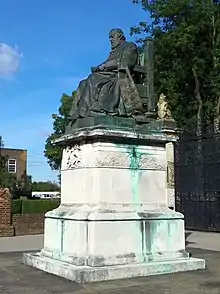 |
Statue of Robert Gascoyne-Cecil, 3rd Marquess of Salisbury | Old Hatfield, Hertfordshire | 1906 | Statue on pedestal | Bronze and stone | Grade II | Q26631553 | [34] | |
.JPG.webp) More images |
Quintin and Alice Hogg Memorial | Portland Place, London | 1906 | Statue group on pedestal | Bronze and limestone | Grade II | Q18595368 | [35][36] | |
 More images |
Queen Victoria | Royal Victoria Infirmary, Newcastle upon Tyne | 1906 | Statue on pedestal | Marble | Grade II* | Q17552314 | [37][16][38] | |
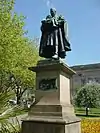 More images |
Major Thomas Lester | St John's Gardens, Liverpool | 1907 | Statue on pedestal | Bronze and stone | Grade II | Q26504975 | [39] | |
 |
Memorial to William McLaren | St. Cuthbert's, Edinburgh | 1907 | Relief sculpture | Stone | ||||
.jpg.webp) More images |
Memorial to Dr Barnardo | Barkingside, London | 1908 | Statue on pedestal with plaque | Bronze and stone | 4.8m high | Grade II* | Q17553256 | [19] |
 |
Lions | Exterior of King Edward VII Galleries, British Museum, London | 1909 | Sculpture | Stone |
1910–1919
| Image | Title / subject | Location and coordinates |
Date | Type | Material | Dimensions | Designation | Wikidata | Notes |
|---|---|---|---|---|---|---|---|---|---|
 More images |
Statue of Peter Pan | Kensington Gardens, London | 1912 | Sculpture group | Bronze | 4.3m high | Grade II* | Q17549621 | [17][40] |
.jpg.webp) More images |
William Thomas Stead | Temple Pier, Victoria Embankment, London | 1913, unveiled 1920 | Plaque | Bronze | Grade II | Q26319157 | A replica was unveiled in Central Park, New York, in 1921.[41] | |
 More images |
Alfred Lewis Jones | Pier Head, Liverpool | 1913 | Statue on pedestal with figures | Bronze and stone | Grade II | Q26320985 | [42] | |
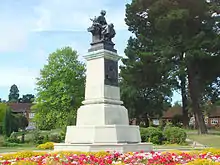 |
William Whiteley | Whiteley Village, Surrey | 1914 | Statue on pedestal with plaques | Copper and stone | 6m high | Grade II | Q26281430 | [43] |
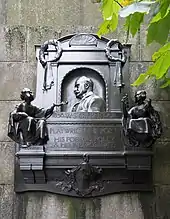 More images |
W. S. Gilbert | Embankment Pier, London | 1914, unveiled 1915 | Plaque on block | Bronze and granite | Grade II | Q27081628 | [44] | |
.jpg.webp) More images |
War memorial | Pearl Assurance offices, Peterborough | 1919 | Statue on pedestal | Bronze and stone | Grade II* | Q62132803 | Relocated from London in 1991[45][46] | |
.jpg.webp) More images |
War memorial | Knowlton, Kent | 1919 | Lantern cross with figures | Stone | Q94131948 | [47] |
1920 and later
| Image | Title / subject | Location and coordinates |
Date | Type | Material | Dimensions | Designation | Wikidata | Notes |
|---|---|---|---|---|---|---|---|---|---|
 More images |
Memorial to Edith Cavell | St Martin's Place, Charing Cross, London | 1920 | Statue with pillar and cross | Carrara marble and granite | 12m high | Grade I | Q18159833 | [48][49][20] |
.jpg.webp) More images |
War memorial | Wittersham, Kent | 1921 | Orb on octagonal column | Portland and Wealden stone | 5m tall | Grade II | Q26676940 | [50][51] |
_(April_2018)_(2).JPG.webp) More images |
Statue of Saint George | Hove War Memorial, Hove, East Sussex | 1921 | Statue on pillar | Stone | Grade II | Q26482745 | Memorial designed by Sir Edward Lutyens[21][52] | |
 More images |
Statue of Saint George | Fordham War Memorial, Fordham, Cambridgeshire | 1921 | Statue on pillar | Stone | Grade II | Q26616619 | Memorial designed by Sir Edward Lutyens, statue stolen 1992.[53][54] | |
 More images |
War memorial | Tonbridge Road, Maidstone | 1922 | Statue on pedestal | Bronze and limestone | Grade II | Q26675478 | [55][56] | |
.jpg.webp) More images |
War memorial | King Edward VII Memorial Park, Cleckheaton | 1922 | Sculpture group on pedestal with surround | Portland stone | Grade II | Q26428794 | [57][58] |
Other works
- Marble statue of Queen Mary, Guildhall Art Gallery, London
- Sandstone reliefs for 177 Ingram St, Glasgow, 1896–1900
- Stone spandrel reliefs for Electra House, Moorgate c.1902
- Kelvingrove Art Gallery and Museum, stone spandrals on the north porch entrance, main face British Colonies saluting the Arms of Glasgow, side returns Love teaching Harmony to the Arts and The Industries of Glasgow at the Court of Mercury
References
- Ian Chilvers (2004). The Oxford Dictionary of Art. Oxford University Press. ISBN 0 19 860476 9.
- University of Glasgow History of Art / HATII (2011). "Sir George James Frampton RA, FSA, LLD". Mapping the Practice and Profession of Sculpture in Britain & Ireland 1851–1951. Retrieved 22 September 2020.
- Frances Spalding (1990). 20th Century Painters and Sculptors. Antique Collectors' Club. ISBN 1 85149 106 6.
- Susan Beattie (1983). The New Sculpture. Paul Mellon Centre for Studies in British Art / Yale University Press. ISBN 0300033591.
- "George Frampton". Oxford Dictionary of National Biography. Oxford: Oxford University Press. 2011. Retrieved 26 October 2011.
- "A Brief History of the Slade School of Fine Art". Archived from the original on 25 January 2008. Retrieved 26 October 2011.
- "Search the Colection: Mother and Child". Victoria & Albert Museum. Retrieved 15 October 2020.
- "Lamia, 1899–1900". The Royal Academy of Arts. Retrieved 11 October 2020.
- Greg Sullivan (28 March 2015). "Material wonders of the Victorian age, Sculpture Victorious". Tate etc. Retrieved 13 October 2020.
- Historic Environment Scotland. "Kelvingrove Park, Kelvingrove Art Gallery and Museum (Category A Listed Building) (LB33071)". Retrieved 12 October 2020.
- Historic England. "Lloyd's Registry (1192466)". National Heritage List for England. Retrieved 12 October 2020.
- M.H. Spielmann (1901). British Sculpture and Sculptors of Today. London: Cassell. pp. 89–95.
- "National Recording Project: Queen Victoria Monument". Public Monuments & Sculpture Association. Retrieved 13 October 2020.
- "Statue of Queen Victoria 1906". Yale Center for British Art. Retrieved 13 October 2020.
- M. Baker (1986). Symbol in Stone: The Art and Politics of a Public Building. Winnipeg: Hyperion Press. p. 119.
- "Queen Victoria (1906) Sculptor: George Frampton". www.northumbria.info. Retrieved 13 October 2020.
- "Sir George Frampton RA (1860–1928)". The Royal Academy of Arts. Retrieved 15 October 2020.
- "A grand entrance on Cromwell Road". Victoria & Albert Museum. Retrieved 25 December 2020.
- Historic England. "Dr Barnardo's Memorial at Barnardo's (1081001)". National Heritage List for England. Retrieved 8 October 2020.
- Lydia Figes (17 March 2020). "Edith Cavell: commemorating the nurse who became a First World War heroine". Art UK. Retrieved 23 October 2020.
- Historic England. "Hove War Memorial (1187556)". National Heritage List for England. Retrieved 9 October 2020.
- "Sir George Frampton's new house in St. John's Wood". Victorianweb.org. 22 December 2010. Retrieved 24 February 2013.
- Historic England. "Rathbone Monument (1073468)". National Heritage List for England. Retrieved 8 October 2020.
- A User's Guide to Public Sculpture. English Heritage / PMSA. 2000. ISBN 185074776 8.
- Historic England. "Statue of Queen Victoria (1075878)". National Heritage List for England. Retrieved 7 October 2020.
- Historic England. "Memorial to Queen Victoria (1255642)". National Heritage List for England. Retrieved 7 October 2020.
- "Statue of Queen Victoria 1906". Yale Centre for British Art. Retrieved 23 January 2021.
- Historic England. "Forwood Memorial (1361683)". National Heritage List for England. Retrieved 8 October 2020.
- Historic England. "Monument of Queen Victoria (1379712)". National Heritage List for England. Retrieved 8 October 2020.
- Historic England. "Lancashire Fusiliers Memorial (1386163)". National Heritage List for England. Retrieved 8 October 2020.
- "War Memorials Register: Salford and Lancashire Fusiliers Boer War". Imperial War Museum. Retrieved 8 October 2020.
- Historic England. "Lancashire Fusiliers Boer War Memorial (1440258)". National Heritage List for England. Retrieved 8 October 2020.
- "War Memorials Register: Lancashire Fusiliers - Boer War". Imperial War Museum. Retrieved 8 October 2020.
- Historic England. "Statue of Third Marquess of Salisbury (1348149)". National Heritage List for England. Retrieved 7 October 2020.
- Historic England. "Statue of Quintin Hogg (In centre of road opposite north end of Broadcasting House) (1226993)". National Heritage List for England. Retrieved 7 October 2020.
- "War Memorials Register: The Polytechnic WW1 and WW2". Imperial War Museum. Retrieved 7 October 2020.
- Historic England. "Statue of Queen Victoria on Front Lawn of Royal Victoria Infirmary (1024801)". National Heritage List for England. Retrieved 8 October 2020.
- "Statue of Queen Victoria 1906". Yale Centre for British Art. Retrieved 23 January 2021.
- Historic England. "Lester Monument (26504975)". National Heritage List for England. Retrieved 8 October 2020.
- Historic England. "Peter Pan statue (West of Serpentine) (1217595)". National Heritage List for England. Retrieved 8 October 2020.
- Historic England. "Memorial to WT Stead, Temple Pier (1066170)". National Heritage List for England. Retrieved 7 October 2020.
- Historic England. "Monument to Sir Alfred Lewis Jones (1068225)". National Heritage List for England. Retrieved 10 October 2020.
- Historic England. "William Whiteley Memorial (1030170)". National Heritage List for England. Retrieved 19 October 2020.
- Historic England. "Memorial to Sir WS Gilbert (1237829)". National Heritage List for England. Retrieved 7 October 2020.
- Historic England. "Pearl Centre war memorial (1462803)". National Heritage List for England. Retrieved 8 October 2020.
- "War Memorials Register: Pearl Assurance". Imperial War Museum. Retrieved 8 October 2020.
- "War Memorials Register: Knowlton - WW1 (Weekly Dispatch Newspaper Bravest Village 1st Place". Imperial War Museum. Retrieved 8 October 2020.
- Historic England. "The Edith Cavell Memorial (1264768)". National Heritage List for England. Retrieved 8 October 2020.
- "War Memorials Register: Edith Cavell". Imperial War Museum. Retrieved 8 October 2020.
- Historic England. "Wittersham War Memorial (1422309)". National Heritage List for England. Retrieved 25 October 2020.
- "War Memorials Register: Wittersham WW1 and WW2". Imperial War Museum. Retrieved 25 October 2020.
- "War Memorials Register: Hove - WW1 and WW2". Imperial War Museum. Retrieved 8 October 2020.
- Historic England. "Fordham War Memorial (1331743)". National Heritage List for England. Retrieved 8 October 2020.
- "War Memorials Register: Fordham". Imperial War Museum. Retrieved 8 October 2020.
- Historic England. "Maidstone Borough War Memorial (1401312)". National Heritage List for England. Retrieved 8 October 2020.
- "War Memorials Register: Maidstone Borough". Imperial War Museum. Retrieved 8 October 2020.
- Historic England. "War Memorial in King Edward VII Memorial Park (1135405)". National Heritage List for England. Retrieved 11 October 2020.
- "War Memorials Register: Cleckheaton". Imperial War Museum. Retrieved 11 October 2020.
External links
| Wikimedia Commons has media related to George Frampton. |